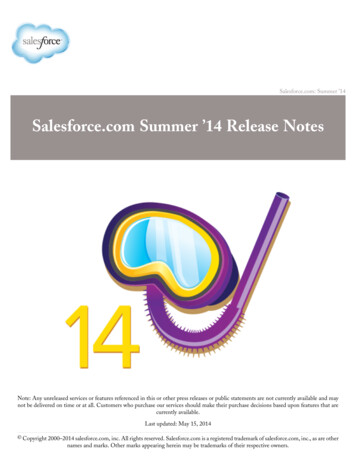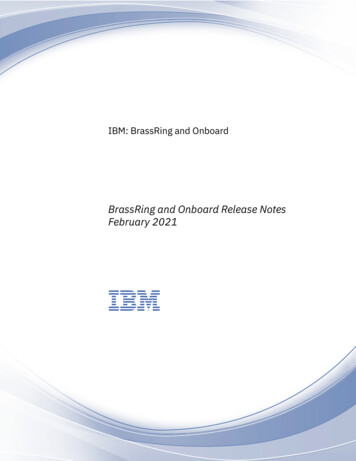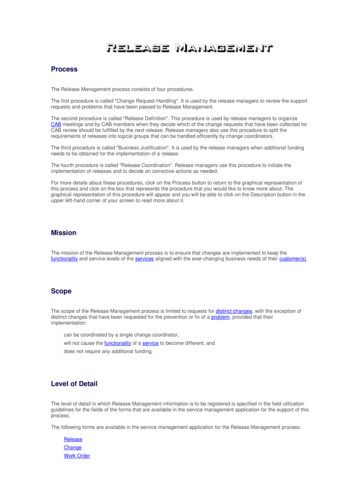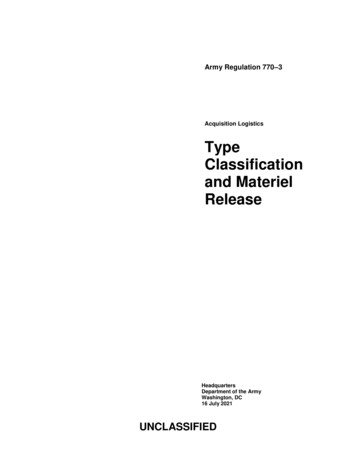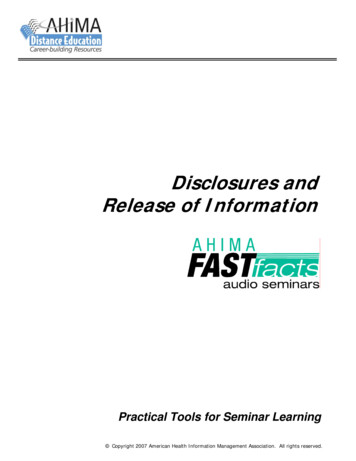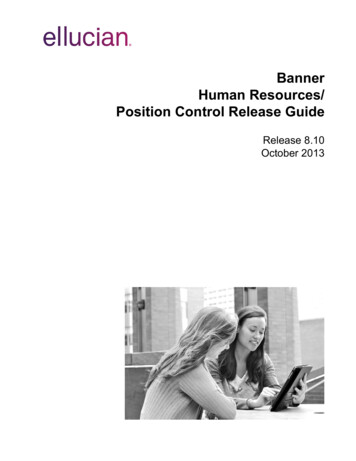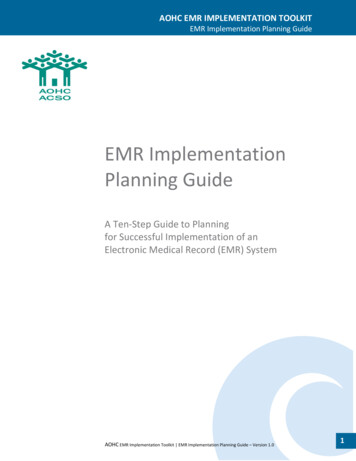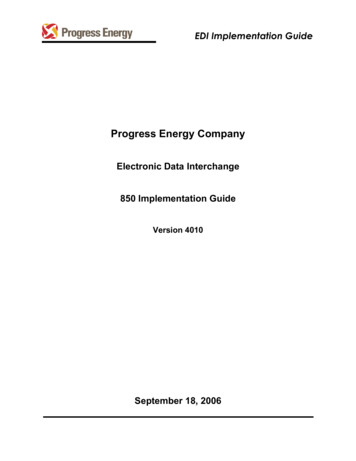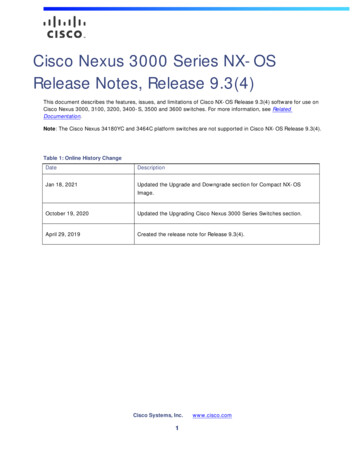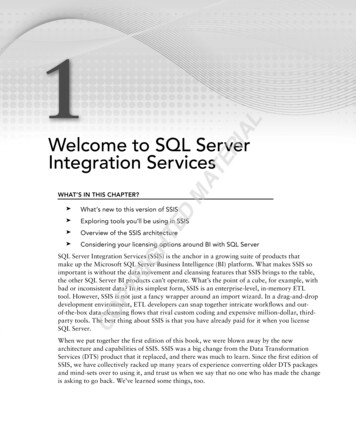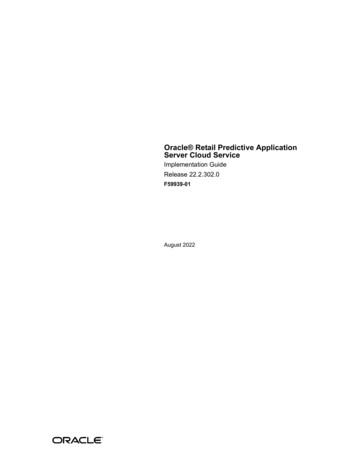
Transcription
[1]Oracle Retail Predictive ApplicationServer Cloud ServiceImplementation GuideRelease 22.2.302.0F59939-01August 2022
Oracle Retail Cloud Edition Implementation Guide, Release 22.2.302.0F59939-01Copyright 2022, Oracle and/or its affiliates. All rights reserved.Primary Author: Judith MeskillContributing Author: Scott CoulterThis software and related documentation are provided under a license agreement containing restrictions on use anddisclosure and are protected by intellectual property laws. Except as expressly permitted in your license agreement orallowed by law, you may not use, copy, reproduce, translate, broadcast, modify, license, transmit, distribute, exhibit,perform, publish, or display any part, in any form, or by any means. Reverse engineering, disassembly, ordecompilation of this software, unless required by law for interoperability, is prohibited.The information contained herein is subject to change without notice and is not warranted to be error-free. If you findany errors, please report them to us in writing.If this is software or related documentation that is delivered to the U.S. Government or anyone licensing it on behalf ofthe U.S. Government, then the following notice is applicable:U.S. GOVERNMENT END USERS: Oracle programs, including any operating system, integrated software, anyprograms installed on the hardware, and/or documentation, delivered to U.S. Government end users are "commercialcomputer software" pursuant to the applicable Federal Acquisition Regulation and agency-specific supplementalregulations. As such, use, duplication, disclosure, modification, and adaptation of the programs, including anyoperating system, integrated software, any programs installed on the hardware, and/or documentation, shall be subjectto license terms and license restrictions applicable to the programs. No other rights are granted to the U.S. Government.This software or hardware is developed for general use in a variety of information management applications. It is notdeveloped or intended for use in any inherently dangerous applications, including applications that may create a risk ofpersonal injury. If you use this software or hardware in dangerous applications, then you shall be responsible to take allappropriate fail-safe, backup, redundancy, and other measures to ensure its safe use. Oracle Corporation and itsaffiliates disclaim any liability for any damages caused by use of this software or hardware in dangerous applications.Oracle and Java are registered trademarks of Oracle and/or its affiliates. Other names may be trademarks of theirrespective owners.Intel and Intel Xeon are trademarks or registered trademarks of Intel Corporation. All SPARC trademarks are usedunder license and are trademarks or registered trademarks of SPARC International, Inc. AMD, Opteron, the AMD logo,and the AMD Opteron logo are trademarks or registered trademarks of Advanced Micro Devices. UNIX is a registeredtrademark of The Open Group.This software or hardware and documentation may provide access to or information about content, products, andservices from third parties. Oracle Corporation and its affiliates are not responsible for and expressly disclaim allwarranties of any kind with respect to third-party content, products, and services unless otherwise set forth in anapplicable agreement between you and Oracle. Oracle Corporation and its affiliates will not be responsible for any loss,costs, or damages incurred due to your access to or use of third-party content, products, or services, except as set forthin an applicable agreement between you and Oracle.Value-Added Reseller (VAR) LanguageOracle Retail VAR ApplicationsThe following restrictions and provisions only apply to the programs referred to in this section and licensed to you. Youacknowledge that the programs may contain third party software (VAR applications) licensed to Oracle. Dependingupon your product and its version number, the VAR applications may include:(i) the MicroStrategy Components developed and licensed by MicroStrategy Services Corporation (MicroStrategy) ofMcLean, Virginia to Oracle and imbedded in the MicroStrategy for Oracle Retail Data Warehouse and MicroStrategyfor Oracle Retail Planning & Optimization applications.(ii) the Wavelink component developed and licensed by Wavelink Corporation (Wavelink) of Kirkland, Washington, toOracle and imbedded in Oracle Retail Mobile Store Inventory Management.(iii) the software component known as Access Via licensed by Access Via of Seattle, Washington, and imbedded inOracle Retail Signs and Oracle Retail Labels and Tags.(iv) the software component known as Adobe Flex licensed by Adobe Systems Incorporated of San Jose, California,and imbedded in Oracle Retail Promotion Planning & Optimization application.You acknowledge and confirm that Oracle grants you use of only the object code of the VAR Applications. Oracle willnot deliver source code to the VAR Applications to you. Notwithstanding any other term or condition of the agreementand this ordering document, you shall not cause or permit alteration of any VAR Applications. For purposes of thissection, "alteration" refers to all alterations, translations, upgrades, enhancements, customizations or modifications ofall or any portion of the VAR Applications including all reconfigurations, reassembly or reverse assembly,re-engineering or reverse engineering and recompilations or reverse compilations of the VAR Applications or anyderivatives of the VAR Applications. You acknowledge that it shall be a breach of the agreement to utilize the
relationship, and/or confidential information of the VAR Applications for purposes of competitive discovery.The VAR Applications contain trade secrets of Oracle and Oracle's licensors and Customer shall not attempt, cause, orpermit the alteration, decompilation, reverse engineering, disassembly or other reduction of the VAR Applications to ahuman perceivable form. Oracle reserves the right to replace, with functional equivalent software, any of the VARApplications in future releases of the applicable program.
ContentsSend Us Your Comments . viiPreface . ixAudience.Documentation Accessibility .Related Documents .Customer Support.Improved Process for Oracle Retail Documentation Corrections.Oracle Retail Documentation on the Oracle Technology Network .Conventions.ixixixixxxx1 ImplementationRequired Skills. 1-1Batch Framework. 1-1Batch Processes Under the Control of the Implementer . 1-2Batch Processes Not Under the Control of the Implementer . 1-2POM Jobs and Batch Exec Service. 1-2Batch Framework Service Catalog . 1-3Batch Exec Service . 1-3Load Measure (Fact) Data: measload . 1-4Export Measure (Fact) Data: measexport . 1-5Mace Calculation Service: calc. 1-7Export Hierarchy: hierexport . 1-7Load PDS Dimension: loaddimdata. 1-8Wait for Trigger File: waittrigger . 1-8Send a Trigger File: sendtrigger. 1-9Extract Input Files from Archive: unpack. 1-9Transform File Service. 1-10Custom Function: ap set datr . 1-13Convert Informal Positions to Formal: formalize . 1-13Rename Positions in a Hierarchy: renamepositions. 1-14Workspace Refresh by Template Name: refresh . 1-14Workspace Rebuild by Template Name: rebuild . 1-14Workspace Delete by Template Name: delete . 1-15Run Segment Build Queue: autobuild . 1-15v
Initialize Testing Environment: initrpac .Execute Automated Tests: runrpac .Automated Testing with RPAC .Application Deploy .Object Storage Upload Location.config .batch control .Bootstrap Environment .OAT Parameters.Config Name .Partition Dim .Batch Group .Overwrite .Application Build -191-192 In-Context HelpNavigating to Help Topics on RPASCE .Creating the Contextual Help Configuration File.Using JSON in the Contextual Help Configuration File.Structure of Contextual Help Configuration File.Help Topic Building Block .Key Naming Convention .JSON Structure of Contextual Help Configuration File .Editing the Contextual Help Configuration File .Retrieve/Update InContext help JSON file: .2-12-32-32-32-42-52-52-62-73 Uploading and Downloading FilesObject Storage . 3-1Accessing Endpoints to Manage Files in Object Storage. 3-1vi
Send Us Your CommentsOracle Retail Cloud Edition Implementation Guide, Release 22.2.302.0Oracle welcomes customers' comments and suggestions on the quality and usefulness of thisdocument.Your feedback is important, and helps us to best meet your needs as a user of our products. Forexample: Are the implementation steps correct and complete? Did you understand the context of the procedures? Did you find any errors in the information? Does the structure of the information help you with your tasks? Do you need different information or graphics? If so, where, and in what format? Are the examples correct? Do you need more examples?If you find any errors or have any other suggestions for improvement, then please tell us yourname, the name of the company who has licensed our products, the title and part number of thedocumentation and the chapter, section, and page number (if available).Before sending us your comments, you might like to check that youhave the latest version of the document and if any concerns are alreadyaddressed. To do this, access the Online Documentation available on theOracle Technology Network Web site. It contains the most currentDocumentation Library plus all documents revised or released recently.Note:Send your comments to us using the electronic mail address: retail-doc us@oracle.comPlease give your name, address, electronic mail address, and telephone number (optional).If you need assistance with Oracle software, then please contact your support representative orOracle Support Services.If you require training or instruction in using Oracle software, then please contact your Oraclelocal office and inquire about our Oracle University offerings. A list of Oracle offices isavailable on our Web site at http://www.oracle.com.vii
viii
PrefaceOracle Retail Implementation Guides provide detailed information useful for implementing andconfiguring the application. It helps you to understand the behind-the-scenes processing of theapplication.AudienceThis document is intended for administrators and system implementers of RPASCE.Documentation AccessibilityFor information about Oracle's commitment to accessibility, visit the Oracle AccessibilityProgram website at http://www.oracle.com/pls/topic/lookup?ctx acc&id docacc.Access to Oracle SupportOracle customers that have purchased support have access to electronic support through MyOracle Support. For information, visithttp://www.oracle.com/pls/topic/lookup?ctx acc&id info or visithttp://www.oracle.com/pls/topic/lookup?ctx acc&id trs if you are hearingimpaired.Related DocumentsFor more information, see the following documents in the Oracle Retail Predictive ApplicationServer Cloud Edition documentation set: Oracle Retail Predictive Application Server Cloud Edition Configuration Tools User Guide Oracle Retail Predictive Application Server Cloud Edition Release Notes Oracle Retail Predictive Application Server Cloud Edition Security Guide Oracle Retail Predictive Application Server Cloud Edition User GuideCustomer SupportTo contact Oracle Customer Support, access My Oracle Support at the following URL:https://support.oracle.comWhen contacting Customer Support, please provide the following: Product version and program/module name Functional and technical description of the problem (include business impact)ix
Detailed step-by-step instructions to re-create Exact error message received Screen shots of each step you takeImproved Process for Oracle Retail DocumentationCorrectionsTo more quickly address critical corrections to Oracle Retail documentation content, OracleRetail documentation may be republished whenever a critical correction is needed. For criticalcorrections, the republication of an Oracle Retail document may at times not be attached to anumbered software release; instead, the Oracle Retail document will simply be replaced on theOracle Technology Network Web site, or, in the case of Data Models, to the applicable MyOracle Support Documentation container where they reside.Oracle Retail documentation is available on the Oracle Technology Network at the umentation/oracle-retail-100266.htmlAn updated version of the applicable Oracle Retail document is indicated by Oracle partnumber, as well as print date (month and year). An updated version uses the same part number,with a higher-numbered suffix. For example, part number E123456-02 is an updated version ofa document with part number E123456-01.If a more recent version of a document is available, that version supersedes all previousversions.Oracle Retail Documentation on the Oracle TechnologyNetworkOracle Retail product documentation is available on the following web on/oracle-retail-100266.html(Data Model documents are not available through Oracle Technology Network. You can obtainthem through My Oracle Support.)ConventionsThe following text conventions are used in this document:xConventionMeaningboldfaceBoldface type indicates graphical user interface elements associated with anaction, or terms defined in text or the glossary.italicItalic type indicates book titles, emphasis, or placeholder variables for whichyou supply particular values.monospaceMonospace type indicates commands within a paragraph, URLs, code inexamples, text that appears on the screen, or text that you enter.
1Implementation1RPASCE acts as a platform to create tailored solutions or migrate existing on-premise solutionsinto the cloud. This guide addresses the process of preparing a custom solution for use in eitherof these Cloud Service environments.Because Oracle Retail Cloud Service applications do not support any back-end server access,implementation is different from an RPAS on-premise implementation. The applicationsprovide online tools to cover all the necessary facets of an RPASCE application roll-out andadministration. These include: Deploying and patching applications from your custom configuration Defining nightly, weekly, or ad hoc batch process sequences Scheduling recurring batch processesRequired SkillsSince implementations are based on a retailer- or implementer-provided configuration, workingknowledge of the RPASCE configuration tools is essential. The RPASCE configuration toolsare supported for offline use on a Windows 10 system. They are available in the applicableStarter Kits, and their use is detailed in the Oracle Retail Predictive Application Server CloudEdition Configuration Tools User Guide.In addition to supplying an RPASCE configuration, the implementer must also prepare theretailer to provide RPASCE Hierarchy (dimension) and Measure (fact) data load files, as wellas to take RPASCE exported Measure (fact) data files for any downstream integration needs.While the implementer does not call the RPASCE command-line utilities directly, knowledgeof their usage gained from the Oracle Retail Predictive Application Server Cloud EditionAdministration Guide is helpful.Data files for loading into the applications and exported files for integration with other systemsare sent and received from the RPASCE cloud environment via Oracle Object Storage.Knowledge of the use of Object Storage File Transfer Service APIs, including an ability toautomate such uploads and downloads, is a necessary prerequisite for routine nightly or weeklybatch processing jobs.Batch FrameworkRPASCE operations require that the administrative user, who will not have command-lineserver access, must be able to select, initiate, and schedule RPASCE batch activities.The RPASCE platform includes an Online Administration Tool (OAT) capability, which allowssimple parameterization and scheduling of pre-configured batch tasks. The RPASCE providesan enhancement to the OAT framework that allows a sequence of several batch tasks to beImplementation 1-1
Batch Frameworkdefined. This sequence is built from a list of available batch services, such as Measure (fact)data loading, calculation, segment workspace refresh, and so on. These service tasks run in adefined order, so that you can know, for example, that your daily data updates have been loadedbefore your workspace refresh tasks are run. The batch tasks are configured to run under theexisting OAT framework, so that scheduling them to run once, or on a repeating basis, is thesame as for other OAT tasks.The batch task sequences are defined in a small set of text files, which are specified below, withsome examples.Batch Processes Under the Control of the ImplementerUsing the RPASCE batch execution framework, the following are under implementer control: List of batch operations to be run, with available parameterization Order in which batch operations are to be run Scheduling of one or more recurring batch tasks, which can be modified by theadministrator, as neededBatch Processes Not Under the Control of the ImplementerDue to the operational and security constraints of the Cloud Service environment, the followingare not under implementer control: Parallelization: The applications automatically parallelize any applicable batch tasks with anumber of processes set to match the provisioned server environment.Script file names, file and directory locations: Custom scripting is not supported for thisenvironment, and no knowledge of file system names or locations is necessary in definingand parameterizing the batch task files.Incoming and outgoing file locations: These details are fixed within the RPASCE CloudService environment.POM Jobs and Batch Exec ServiceProcess Orchestration and Monitoring (POM) is the enterprise batch-scheduling solution forretail applications migrating to the cloud. In POM, the RPASCE schedule contains multiplestatic jobs for each RPASCE application, namely, three daily jobs (jos daily pre, jos daily, andjos daily post) and three weekly jobs (jos weekly pre, jos weekly, and jos weekly post).These jobs must exist in batch exec list and can map to other batch control sets for the BatchExec Service.For example, the following section in the batch exec list defines the mappings for the POMjobs.# Entries for scheduling in JOS/POMjos daily pre exec *hook jos daily prejos daily exec batch dailyjos daily post exec *hook jos daily postjos weekly pre exec *hook jos weekly prejos weekly pre exec batch weekly prejos weekly exec batch weeklyjos weekly post exec *hook jos weekly postIn this example, the job weekly is configured to execute the batch weekly control set, which isa set of tasks within the batch exec list that can be configured in the same way as you would ifnot using POM. The "*" before the control set name indicates that this control set is optional,1-2 Oracle Retail Cloud Edition Implementation Guide
Batch Framework Service Catalogthat is, if it does not exist, the batch execution of the POM job just ignores it without reportingany errors.For more details about the RPASCE Schedule for POM, refer to the Oracle Retail PredictiveApplication Server Cloud Edition Administration Guide.Batch Framework Service CatalogThis section describes the batch services that are available to be configured.Batch Exec ServiceThe Batch Exec service is the controller for all the other services, specifying groups of tasks tobe run, their sequences, and top-level parameters.The Batch Exec service groups are specified in a text file batch exec list.txt. In this file, eachactive line takes this form:batch type service service parameterThe first column is an identifier, which may be repeated on several lines to define a grouping oftasks to be run together. The second column indicates which task from the catalogue is beingrequested. The third column gives parameter details for that task (as necessary). Commentsmay be placed in the batch exec list.txt file by starting a comment line with the hash sign (#).Here is a sample batch exec list.txt file for reference:# Dailydaily daily daily daily daily daily daily daily Batch Cylewaittrigger daily upd.txt 3600unpack daily upd.zipcalc exp setmeasexport daily exp setmeasload load oo listsendtrigger batch load complete.txt ftpcalc batch oorebuild rebuild daily group# Batch Cycle to Load OOload oo measload load oo listload oo calc batch oo# Weeklyweekly weekly weekly weekly weekly weekly weekly weekly weekly weekly weekly weekly Batch measloadcalccalcrefreshrebuildautobuild exp calc setweekly exp setclnd 14 Nprod 14 Nloc 14 Nload act listload oo listbatch weekbatch fcstrefresh weeklyrebuild weeklyIn this sample file, three batch task groups are specified: daily, load oo, and weekly. Note thatthese names are implementer-defined identifiers; there is nothing special about the names"daily" or "weekly". Each identifier is thus associated with a sequence of tasks, which will runin the order they are listed in the file.Implementation 1-3
Batch Framework Service CatalogNote also that no information is provided about times or schedules on which these task groupsshould be run. Scheduling information must be specified in the RPASCE Online AdministrationTool.The services listed for each batch task group are run in the order specified when that type ofbatch run is requested through the OAT interface. Details on the individual batch services andwhat their service parameters mean are described in the following sections.Load Measure (Fact) Data: measloadThe Load Measures service allows the loading of one or several measures, the data for whichmay be found in one or several files. The measload service will check for the required data filesin the Object Storage incoming files area. The service will optionally either validate thepresence of all data files and treat this as an error condition, or treat the presence of files asoptional and continue with no error if the files are not present.Groups of measures to be loaded are specified in a control file, batch loadmeas list.txt, withthe columns as follows: Load set name Parameter type, which must be one of the following: –H - Fact data file name–V - Validate option, if present, indicates missing data files are to be treated as an errorcondition. No third-column parameter required.–R - Rejected record threshold (optional). Requires third column parameter; it must bea positive integer. When this parameter is presented, the process will be stopped (errorcode 37) with a failure trigger when the number of rejected records exceeds thenumber specified. If this option is not specified, a warning trigger will be created ifthere are any rejected records in the measure load; however, the process will continue.–C - RPASCE v19 parameter, which is no longer supported.–M - RPASCE v19 parameter, which is no longer supported.–S - RPASCE v19 parameter, which is no longer supported.Parameter value. Relative to the parameter type specified above.Fact Data files may contain the data for one or several facts in a comma-separated value format(CSV) with a header line.Here is an example control file for the Load Measure service:# Load Forecast Measuresload fcst R 200load fcst V load fcst H mp fcst.csv.ovrload fcst H mt fcst.csv.ovrload fcst H lp fcst.csv.ovrload fcst H lt fcst.csv.ovrIn this example, if any files for the listed measures are absent, an error condition will bereported.The Validate option checks for required data files in the internal input file directory, as well asfiles that have been placed in Object Storage. This allows the measload task's Validate option tocorrectly detect files that were previously placed in the internal input location by an unpackbatch task.1-4 Oracle Retail Cloud Edition Implementation Guide
Batch F
Creating the Contextual Help Configuration File In-Context Help 2-5 Key Naming Convention The naming convention of the key depends upon the level or sub-level of each element. Here is an example of the naming conventions at different levels. Consider the solution in use is mfprcs. JSON Structure of Contextual Help Configuration File
